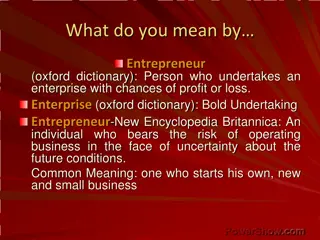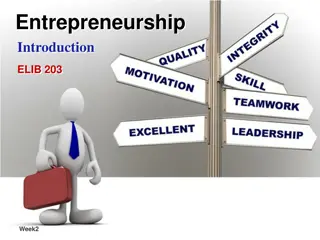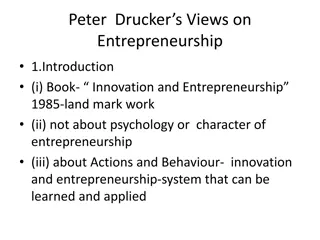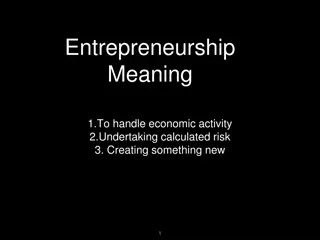Understanding Entrepreneurship and Small Business Management
Entrepreneurs recognize opportunities, add value to resources, and play a vital role in the economy through their innovation and risk-taking. Small businesses, with less than 500 employees, make up a significant portion of the U.S. business landscape, offering independence and financial rewards but also facing challenges like business failure and long hours. Becoming an entrepreneur brings benefits like independence and contribution to society but also comes with costs such as financial insecurity and personal relationship strains.
Download Presentation

Please find below an Image/Link to download the presentation.
The content on the website is provided AS IS for your information and personal use only. It may not be sold, licensed, or shared on other websites without obtaining consent from the author. Download presentation by click this link. If you encounter any issues during the download, it is possible that the publisher has removed the file from their server.
E N D
Presentation Transcript
ENTREPRENEURSHIP AND SMALL BUSINESS MANAGEMENT Chapter 1 Entrepreneurs Recognize Opportunities
Businessbuying and selling products and services What is business? Product something tangible that exists in nature or is made by people Service intangible work that provides time, skills, or expertise
What is an Entrepreneur? EMPLOYEES WORK FOR SOMEONE ELSE S BUSINESS. ENTREPRENEURS START THEIR OWN BUSINESSES AND WORK FOR THEMSELVES.
Entrepreneurs add value to scarce resources. A scarce (limited) resource is something of value that can be used to make something else or fill a need. Entrepreneurs add value to scarce resources by what they do with those resources.
The economic questions WHAT SHOULD BE PRODUCED? WHEN WILL IT BE PRODUCED? HOW WILL IT BE PRODUCED? WHO WILL PRODUCE IT? WHO GETS TO HAVE WHAT IS PRODUCED? AN ECONOMY IS A COUNTRY S FINANCIAL STRUCTURE. IT IS THE SYSTEM THAT PRODUCES AND DISTRIBUTES WEALTH.
Economic system in which businesses can be privately owned and operated Free- enterprise system Based on voluntary exchange Encourages competition between entrepreneurs Can lead to a loss of jobs and capital if a company fails
Less than 500 employees What is a small business? About 99.9% of the 27.2 million U.S. businesses are small. Small businesses employ about 50% of the U.S. private workforce. Annual sales under $5 million
Why be an Entrepreneur? Control over time Fulfillment Creation/ownership Control over compensation Control over working conditions
Benefits and Costs of Becoming an Entrepreneur Benefits Independence Satisfaction Financial reward Self-esteem Contribution to society Costs Business failure Obstacles Loneliness Financial insecurity Long hours/hard work Strain on personal relationships
Benefit/Cost Analysisa decision-making process in which the costs of taking an action are compared to the benefits Benefits money, knowledge, and experience you will gain Costs money and time you must invest Benefit/Cost Analysis Opportunity Cost the value of what must be given up in order to obtain something else For a benefit/cost analysis to be accurate, opportunity cost must be included.
Keys to avoiding missteps Explore options thoughtfully and systematically Research Educational courses and workshops Learn from the experience of others Formal mentors Informal advisors
Traditional for-profit enterprise Social entrepreneurship for-profit enterprise with dual goals of profitability and social returns Entrepreneurial Opportunities Venture philanthropy Green entrepreneurship Not-for-profit organization
Schumpeters Sources of Opportunity Use a new technology to produce a new product. Use an existing technology to produce a new product. Use an existing technology to produce an old product in a new way. Find a new source of resources to produce more efficiently. Develop a new market for an existing product.
SCHUMPETERS SOURCES OF OPPORTUNITY
Not all ideas are opportunities An opportunity is an idea that is based on what consumers need or want and are willing to buy sufficiently often at a high enough price to sustain a business. Opportunity is situational: dependent on variable circumstances.
Timmons Business Opportunity = Idea + Four Characteristics Will work in the business environment Attractive to customers Can be executed in an existing window of opportunity Available resources and skills needed to create the business
Use SWOT Analysis to Evaluate Business Ideas Strengths What does the organization do better than the competitor? a strong brand, loyal customer base, a strong balance sheet, unique technology Weaknesses What areas the business needs to improve to remain competitive? higher-than-average turnover, high levels of debt, an inadequate supply chain Opportunities What market trends could lead to increased sales? if a country cuts tariffs, a car manufacturer can export its cars into a new market, increasing sales Threats What are the advantages competitors have over the organization? rising costs for materials, increasing competition, tight labor supply
Problems your business can solve Changes in laws, situations or trends 5 Roots of Opportunity Inventions of new products or services Competitive advantage in price, location, quality, reputation Technological advances that entrepreneurs can take from the laboratory to the marketplace The best business opportunities often combine both internal and external factors.
Product uniquenessability to differentiate the product/service from those of the market s competitors Components of Porter s Generic Strategies Low cost ability to reduce costs and sustain a price advantage Focus targeting a particular market segment or group niche
Start and build Start and build a new business Inherit Inherit a business Pathways to Entrepreneurship Secure Secure franchise rights Buy Buy an existing business License or purchase License or purchase technology
Profitamount remaining after costs are deducted from the firm s income Profit signals that an entrepreneur is adding value to scarce resources. Entrepreneurs try to make choices (trade-offs) that will increase profit. Profit is a sign of Success
Seven steps to Success Evaluate it with critical thinking (SWOT) Recognize an opportunity Build a team Write a realistic business plan Gather resources Decide ownership Create wealth

























